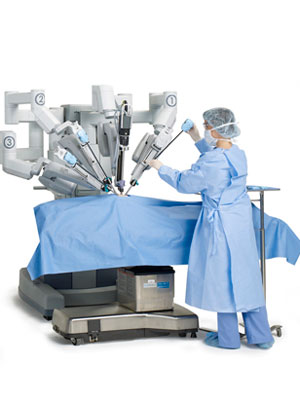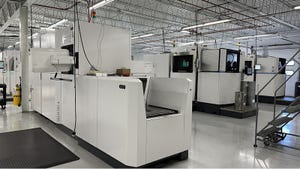September 27, 2010

Laparoscopyis a surgical approach in which long-shafted instruments are inserted throughsmall incisions to access targeted anatomy. Compared with traditional openprocedures, laparoscopy has revolutionized surgical treatment by shorteningrecovery time with less pain and fewer adhesions, resulting in better post-operativequality of life. However, manual laparoscopy has several limitations, includinglack of depth perception, poor camera control, limited degrees of freedom forthe instrument tips, and inverted hand-instrument movements. These limitationslead to unnatural and painful surgical postures that result in surgeon fatigue.
Robotic-assisted laparoscopy, such as the da Vinci system, allows the surgeon tosit at a stereo console and remotely control endoscopic instruments via a patient-siderobot. The da Vinci system consists of three components: the surgeon console, apatient-side cart that holds the instruments, and the image processingequipment. The system's 3-D visualization provides depth perception, and thewrist-like articulations of the miniaturized instruments improve surgeons'dexterity and range-of-motion. The system also improves control by reducinghand tremor and providing motion scaling. The ergonomic instrument-hand-eyealignment and intuitive instrument movement can also reduce surgeon trainingtime in comparison to using manual laparoscopy.
Robotic Surgical System Overcomes Manual Limitations_B |
The da Vincisystem is based on foundational robotic surgerytechnology developed at SRI (formerly known as Stanford Research Institute). Intuitive Surgical later formedrelationships with IBM, Massachusetts Institute of Technology, and HeartportInc. to further develop the system. The FDA has cleared the da Vinci for a rangeof general, thoracic, urological, gynecological, head and neck, and cardiacprocedures in both adults and children.
da Vinci Explained
The daVinci system requires up to five small (<1 cm) incisions for insertion ofthe two surgical manipulators and a camera. The da Vinci patient-side cartholds the instruments docked to the patient as surgical assistants stand overthe patient. Meanwhile, the surgeon can operate the system while seated acrossthe room at the console, where the look and feel of the open surgery is replicated.The surgeon performs movements using masters (which help translate surgerymotions). The surgeon's fingers grasp the master controls below the displaywith wrists naturally positioned relative to his or her eyes. The surgeon'smovements are then translated into precise, real-time robotic movements insidethe patient.
Therobotic masters are controlled by the surgeon through wrist, hand and finger movements,just as with a typical open surgery. A full range of optional EndoWristInstruments are also provided for the system. These instruments are designedwith seven degrees of motion that exceed the dexterity of the human wrist. Eachinstrument has a specific surgical mission such as clamping, suturing andtissue manipulation.
Thepatient-side cart houses the two robotic arms and one endoscope arm, whichduplicate the surgeon's movements. The laparoscopic arms pivot at the operatingport, eliminating the use of the patient's body wall for leverage, thusminimizing tissue and nerve damage. Supporting surgical team members installthe correct instruments, prepare the port in the patient, and supervise thelaparoscopic arms and tools being used.
Robotic Surgical System Overcomes Manual Limitations_C |
Actuation Design
The da Vinci surgical system incorporateshigh-end motion control technologies so that every motion provides the smooth,accurate movements reminiscent of a skilled surgeon - even at slow, calculatedspeeds. Each da Vinci S HD System contains more than 30 motors manufactured by Maxon Precision Motors. These motorsare located at the heart of each manipulator.
TheMaxon motors provide the inputs and outputs to the da Vinci System. Through a series of feedback controls, themotors and encoders receive inputs from the surgeon, are translated inreal-time through the console electronics, and provide output signals to themotors in the manipulators. In turn, the manipulators exert forces back throughthe console electronics to the surgeon's hands.
Maxonmotors are designed with rare earth magnets in their stators and incorporate anironless rotor design that eliminates magnetic cogging, even at slow operatingspeeds.
The surgeon'sside cart employs motors referred to as masters to distinguish their dual role.The slave side, or manipulator motors, require the same precision, but alsoneed to be able to be backdriven while an assistant surgeon moves the endeffectors into position. The motors exhibit low hysteresis at the instrumenttips.
Amongthe more than 30 motors used by Intuitive's engineers in the da Vinci system,are the RE 25 motor, some with and some without encoder feedback; RE 13 mmmotors equipped with GP 13 series gearheads and 13 mm magnetic encoders; and RE35 series motors with third-party encoders.
Maxonmotors are key to each da Vinci system critical performance characteristictests, including friction, backlash and compliance profiles, as well as a rangeof sensor feedback monitoring, says Mike Prindiville, manager, manufacturing engineeringfor Intuitive Surgical.
Software-Based Training
Although the prevalence of robotic-assisted,minimally invasive surgery has increased tremendously, training opportunities remainrelatively limited. Because comprehensive practice and experience is necessaryin order to develop proficiency with a sophisticated tool such as the da Vinci system, the development of trainingaids for robotic surgery is critical in helping meet the demand for this technique.
At the Nebraska Biomechanics CoreFacility in the HPER Biomechanics Lab. at the University of Nebraska at Omaha,a group of Ph.D. students work with the Robotic Surgical Lab. at theuniversity's medical center to develop a computer training program for roboticsurgery where new surgeons can learn how to use this advanced technology.
Robotic Surgical System Overcomes Manual Limitations_A |
Two training platforms have been developed with NationalInstruments' LabVIEW graphical programming software. The first is designedfor monitoring and recording a surgeon's performance during a training programand ensuring that the surgery is performed using the correct movements. Thistraining platform also incorporates visual real-time feedback to show traineeshow much force they apply on the training task or animate tissue. This visualfeedback helps trainees reduce tissue damage inflicted during the procedure.
LabVIEW was also used to create aworking environment for robotic surgery training in virtual reality. Thissecond training platform offers flexibility to conduct research by collectingdata and adjusting training tasks in the virtual simulator via Ethernet.Virtual robotic surgical training allows multiple surgeons to trainsimultaneously using software instead of actual medical equipment. This processprovides problem-based training protocols for new surgeons to learn roboticsurgery.
All of the data communications onthe da Vinci robotic surgical system is acquired via TCP/IP using NI's USB-6009data acquisition board to connect to the electromyography system andelectrogoniometers. These connections acquire physiological measurements, suchas muscle activations and joint angles, from the surgeons. Using this data,researchers and medical personnel can objectively evaluate surgical proficiencybefore and after the robotic surgical training protocol.
About the Author(s)
You May Also Like








